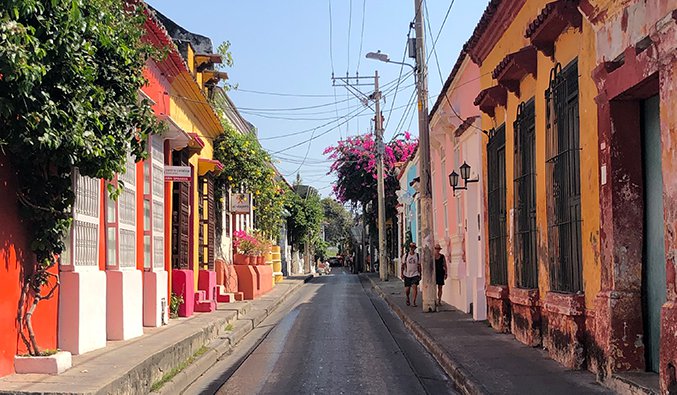Cartagena: a city of color, tourists, and food

During the narco heydays, Cartagena was considered the only “safe” spot in Colombia for tourists. It was where foreigners vacationed, cruise ships docked, and rich Colombians built their vacation homes.
Today, this colorful colonial city remains one of the most popular destinations for tourists and Colombians alike. Rich Colombians — and now foreigners — still build vacation homes here, cruise ships still dock, and the influx of tourists has grown with an increasing number of direct flights from North America and Europe.
Out of all the stops on my Colombian tour, Cartagena was the place I was least excited about.
As one of the best-preserved and historic cities in Colombia, I knew I would love its narrow colonial streets, ancient walls, grand plazas, and Spanish-style houses with their giant doors and wooden terraces, not to mention the restaurants whose tables spilled into busy plazas.
But I was not so eager to be in such a touristy, crowded city for five long days. A friend was flying down for a quick vacation and he was not keen to go elsewhere on a long bus. I would be stuck in this tiny, tourist town.
Cartagena turned out to be everything I thought it would be.
Brightly painted houses with hanging flower gardens lining a narrow street in Cartagena, Colombia
It had the kind of heat and humidity that melted you in place, it was very expensive, and it was filled with throngs from cruises, tours, bachelor and bachelorette parties, and gringos trying to score drugs (and shady streetside pushers happy to oblige).
Throw in packed streets and too few “tourist” activities and I was ready to get out of there as soon as I had arrived. (Seriously. After a couple of museums, a walking tour, and a visit to a beach or two, you’ve pretty much seen the city.)
But, when it did come time to leave, I found myself downright crestfallen.
I had grown to really love Cartagena.
In the midst of all those touts and tourists, I found an architecturally beautiful and vibrant city. A place on whose edges the crowds disperse and lovely little Colombian cafés appear. A city with cutting-edge restaurants, lively music, town squares full of life, and funky bars.
Early in the morning, before the heat of the day drove me inside and the cruise ships let their armies loose, I’d wander the empty streets of the old town, taking copious pictures as the light dangled perfectly between streets. I got my tea and breakfast at the same shops. Waved hello to locals sitting in the parks. Busy Cartagena is a quiet little town at 8am.
In Getsemani, the backpacker area, I found colorful homes, squares filled with street vendors, cheap eateries, and heaving bars. I’d sit at night with my street food watching bands and street performers, including a duo who flawlessly reenacted “Thriller.”
And, in Bocagrande, a Miami-style neighborhood for the rich and famous, I saw how the well-to-do lived, enjoyed some of the better beaches in the area, and strolled along its long promenade.
My friend and I dove into the city’s fabulous gastronomy scene and gorged on delicious ceviche, empanadas, brick-oven pizza, and traditional Colombian food. The food scene here was one of the best in Colombia. (It was really impressive for such a small city. See the bottom of the post for recommendations.)
In beautiful colors that must be mandated by the government, the vibrantly painted buildings and heavy doors with shapes and designs that could be their own blog gave Cartagena an upbeat feel to it.
Spending extra time doing nothing allowed me to linger a bit longer, explore some hole-in-the-wall shops, sit along squares with a beer, and head over to the least touristy beach possible:


